Resourcing the Organisation: Recruitment Strategies and HRM Objectives
VerifiedAdded on 2023/01/05
|11
|3735
|48
Report
AI Summary
This report delves into the concept of resourcing within organizations, emphasizing its critical role in aligning human resource capabilities with operational and strategic objectives. It defines resourcing, highlighting its strategic imperatives of cost reduction, employee value enhancement, and the development of a suitable behavioral mix within the workforce. The report explores various recruitment methods, differentiating between internal and external approaches, and provides a detailed evaluation of employee leasing, including its advantages such as cost control, access to benefits, and legal compliance, along with disadvantages like reduced control. The report also examines the role of resourcing in achieving key human resource management objectives, such as hiring the right candidates, fulfilling legal responsibilities, and managing performance and productivity. Additionally, it discusses alternatives to recruitment, such as employee leasing, subcontracting, temporary employment, and outsourcing, and their potential benefits and drawbacks. This report aims to enhance understanding of how effective resourcing strategies support organizational growth and success.
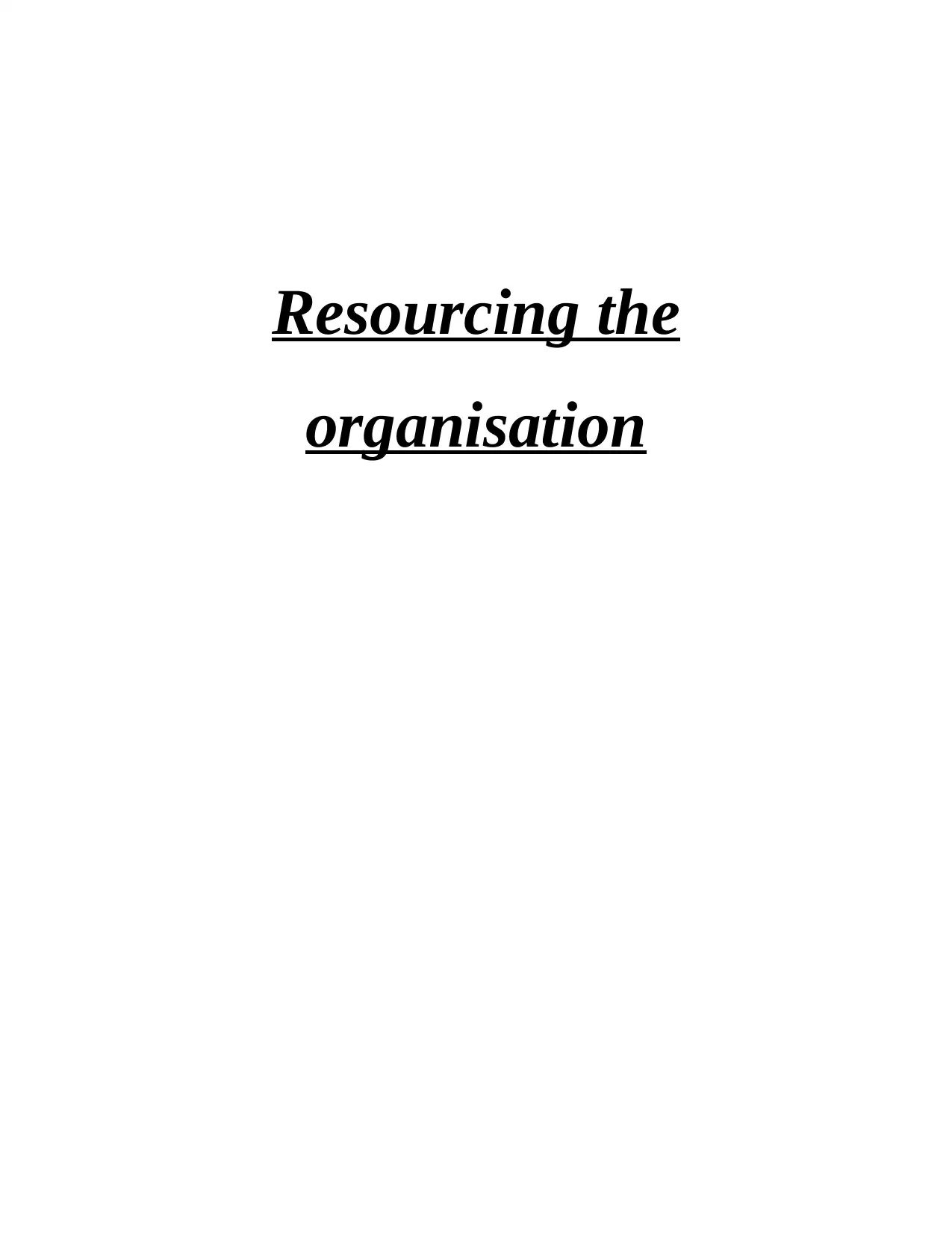
Resourcing the
organisation
organisation
Paraphrase This Document
Need a fresh take? Get an instant paraphrase of this document with our AI Paraphraser
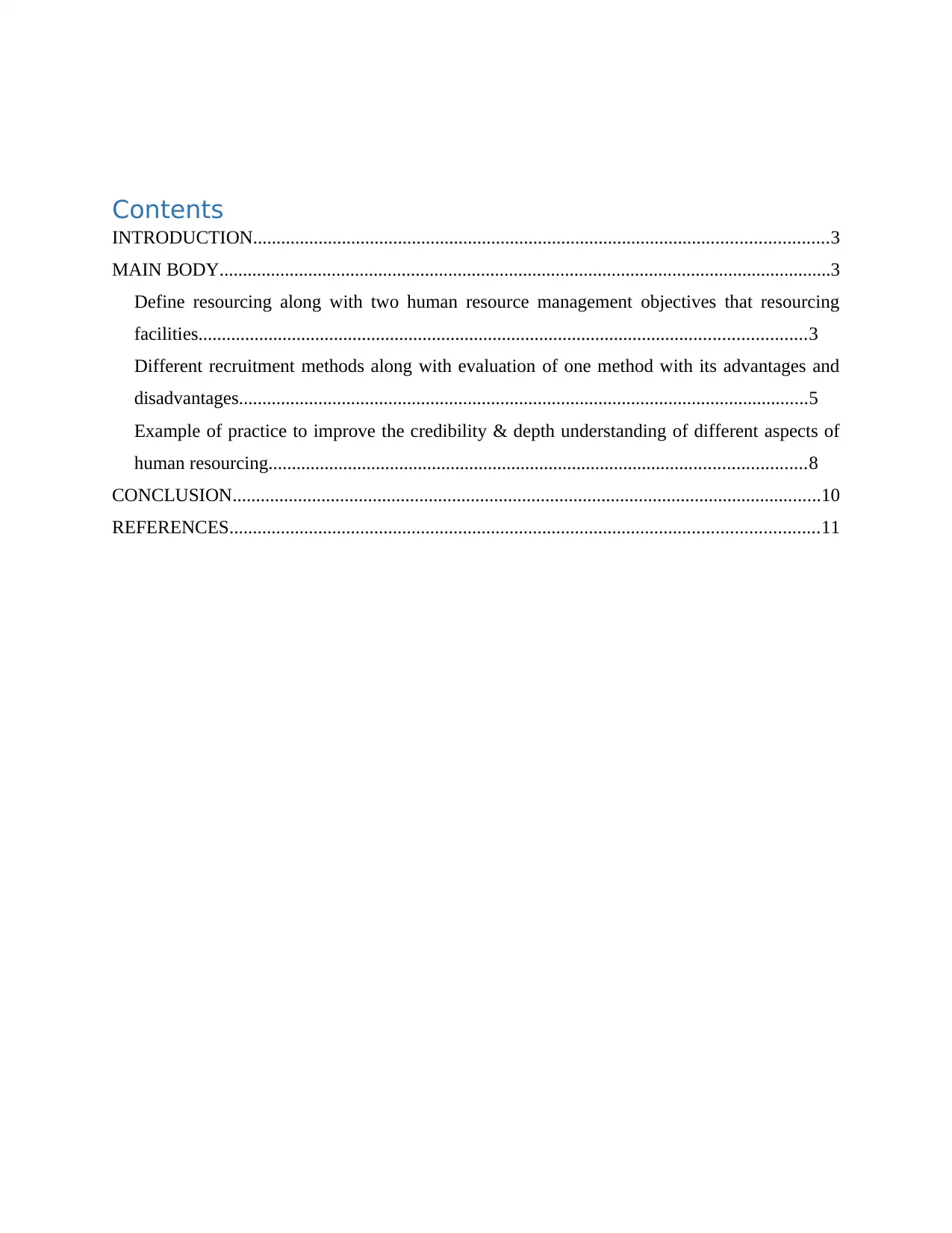
Contents
INTRODUCTION...........................................................................................................................3
MAIN BODY...................................................................................................................................3
Define resourcing along with two human resource management objectives that resourcing
facilities..................................................................................................................................3
Different recruitment methods along with evaluation of one method with its advantages and
disadvantages..........................................................................................................................5
Example of practice to improve the credibility & depth understanding of different aspects of
human resourcing...................................................................................................................8
CONCLUSION..............................................................................................................................10
REFERENCES..............................................................................................................................11
INTRODUCTION...........................................................................................................................3
MAIN BODY...................................................................................................................................3
Define resourcing along with two human resource management objectives that resourcing
facilities..................................................................................................................................3
Different recruitment methods along with evaluation of one method with its advantages and
disadvantages..........................................................................................................................5
Example of practice to improve the credibility & depth understanding of different aspects of
human resourcing...................................................................................................................8
CONCLUSION..............................................................................................................................10
REFERENCES..............................................................................................................................11
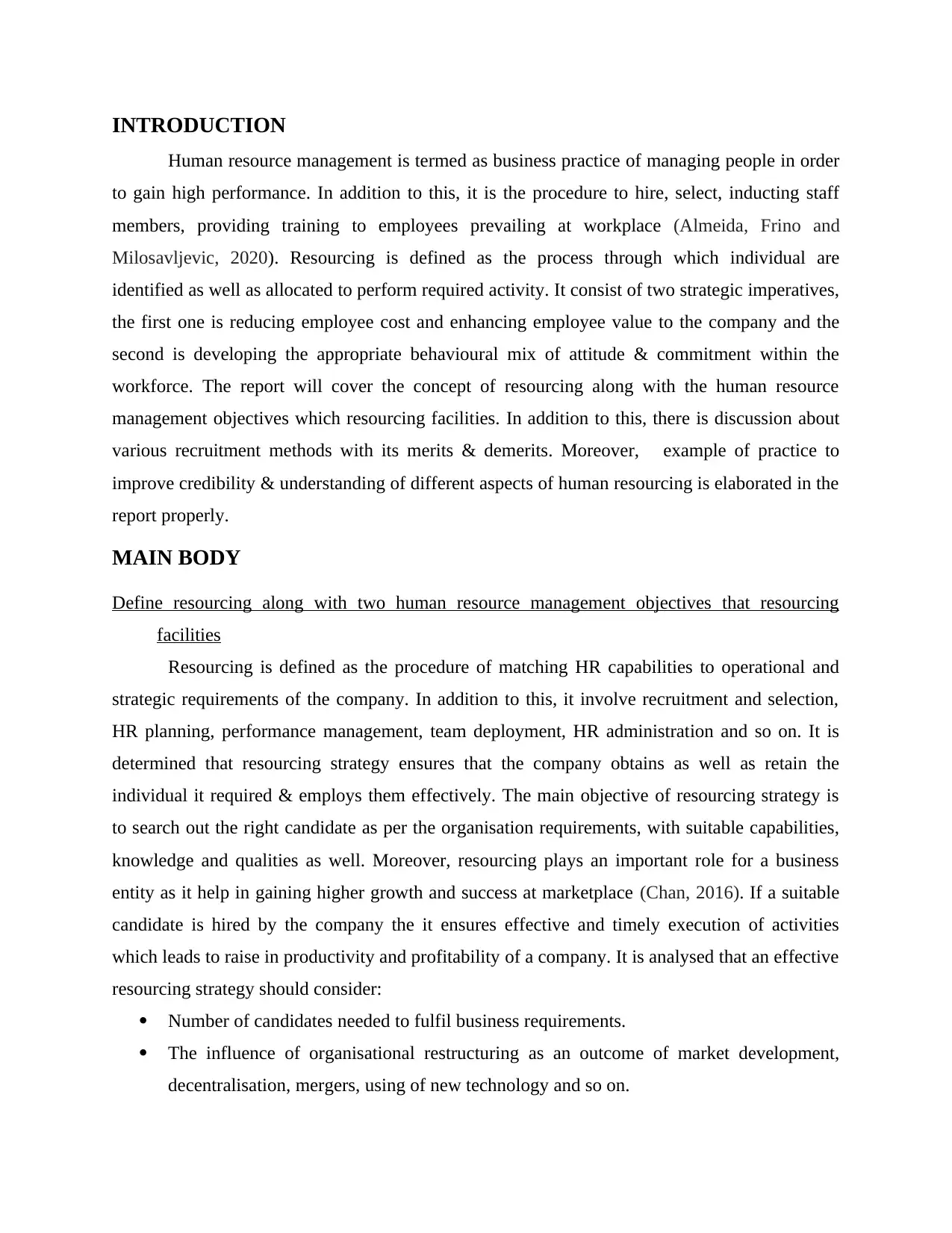
INTRODUCTION
Human resource management is termed as business practice of managing people in order
to gain high performance. In addition to this, it is the procedure to hire, select, inducting staff
members, providing training to employees prevailing at workplace (Almeida, Frino and
Milosavljevic, 2020). Resourcing is defined as the process through which individual are
identified as well as allocated to perform required activity. It consist of two strategic imperatives,
the first one is reducing employee cost and enhancing employee value to the company and the
second is developing the appropriate behavioural mix of attitude & commitment within the
workforce. The report will cover the concept of resourcing along with the human resource
management objectives which resourcing facilities. In addition to this, there is discussion about
various recruitment methods with its merits & demerits. Moreover, example of practice to
improve credibility & understanding of different aspects of human resourcing is elaborated in the
report properly.
MAIN BODY
Define resourcing along with two human resource management objectives that resourcing
facilities
Resourcing is defined as the procedure of matching HR capabilities to operational and
strategic requirements of the company. In addition to this, it involve recruitment and selection,
HR planning, performance management, team deployment, HR administration and so on. It is
determined that resourcing strategy ensures that the company obtains as well as retain the
individual it required & employs them effectively. The main objective of resourcing strategy is
to search out the right candidate as per the organisation requirements, with suitable capabilities,
knowledge and qualities as well. Moreover, resourcing plays an important role for a business
entity as it help in gaining higher growth and success at marketplace (Chan, 2016). If a suitable
candidate is hired by the company the it ensures effective and timely execution of activities
which leads to raise in productivity and profitability of a company. It is analysed that an effective
resourcing strategy should consider:
Number of candidates needed to fulfil business requirements.
The influence of organisational restructuring as an outcome of market development,
decentralisation, mergers, using of new technology and so on.
Human resource management is termed as business practice of managing people in order
to gain high performance. In addition to this, it is the procedure to hire, select, inducting staff
members, providing training to employees prevailing at workplace (Almeida, Frino and
Milosavljevic, 2020). Resourcing is defined as the process through which individual are
identified as well as allocated to perform required activity. It consist of two strategic imperatives,
the first one is reducing employee cost and enhancing employee value to the company and the
second is developing the appropriate behavioural mix of attitude & commitment within the
workforce. The report will cover the concept of resourcing along with the human resource
management objectives which resourcing facilities. In addition to this, there is discussion about
various recruitment methods with its merits & demerits. Moreover, example of practice to
improve credibility & understanding of different aspects of human resourcing is elaborated in the
report properly.
MAIN BODY
Define resourcing along with two human resource management objectives that resourcing
facilities
Resourcing is defined as the procedure of matching HR capabilities to operational and
strategic requirements of the company. In addition to this, it involve recruitment and selection,
HR planning, performance management, team deployment, HR administration and so on. It is
determined that resourcing strategy ensures that the company obtains as well as retain the
individual it required & employs them effectively. The main objective of resourcing strategy is
to search out the right candidate as per the organisation requirements, with suitable capabilities,
knowledge and qualities as well. Moreover, resourcing plays an important role for a business
entity as it help in gaining higher growth and success at marketplace (Chan, 2016). If a suitable
candidate is hired by the company the it ensures effective and timely execution of activities
which leads to raise in productivity and profitability of a company. It is analysed that an effective
resourcing strategy should consider:
Number of candidates needed to fulfil business requirements.
The influence of organisational restructuring as an outcome of market development,
decentralisation, mergers, using of new technology and so on.
⊘ This is a preview!⊘
Do you want full access?
Subscribe today to unlock all pages.

Trusted by 1+ million students worldwide
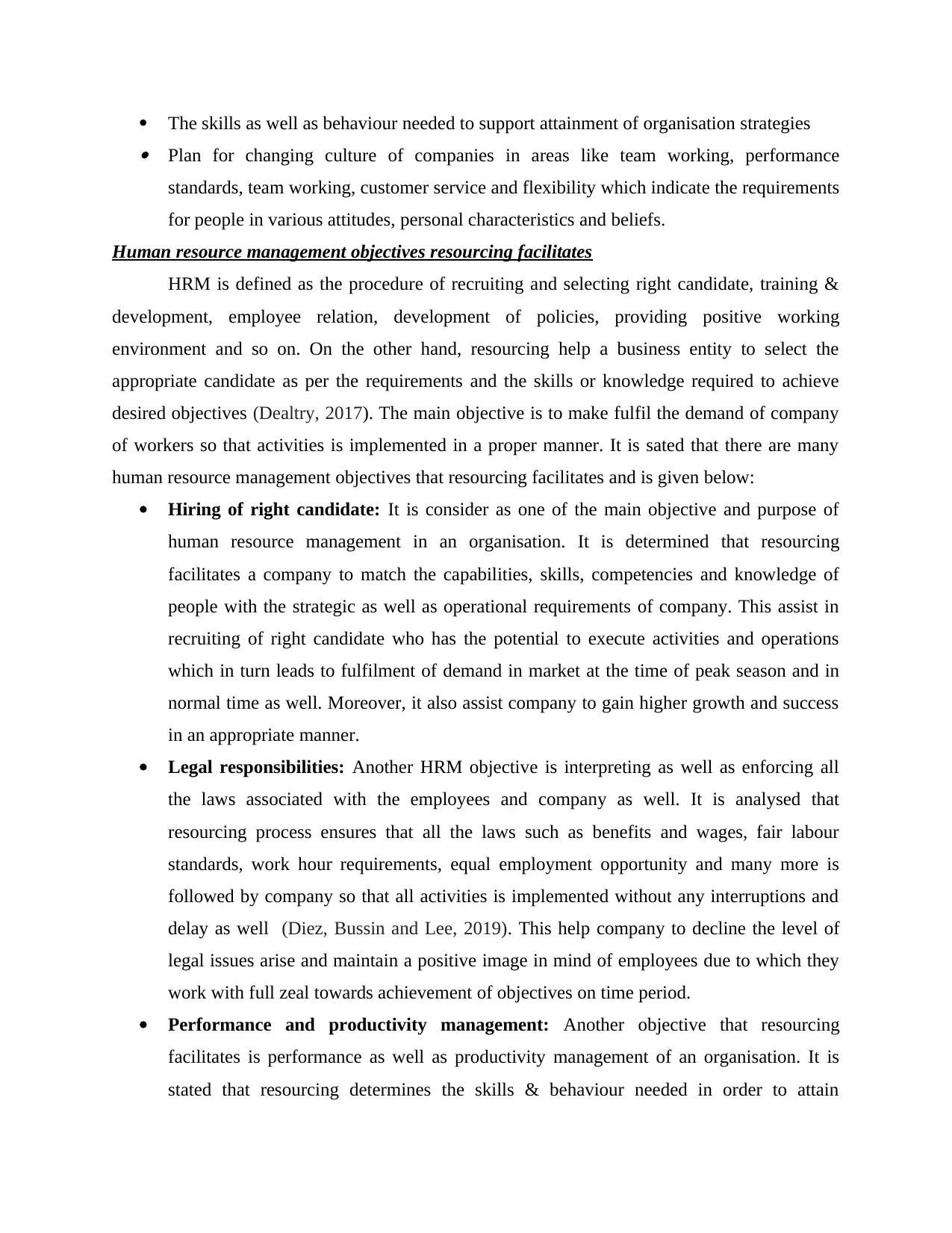
The skills as well as behaviour needed to support attainment of organisation strategies Plan for changing culture of companies in areas like team working, performance
standards, team working, customer service and flexibility which indicate the requirements
for people in various attitudes, personal characteristics and beliefs.
Human resource management objectives resourcing facilitates
HRM is defined as the procedure of recruiting and selecting right candidate, training &
development, employee relation, development of policies, providing positive working
environment and so on. On the other hand, resourcing help a business entity to select the
appropriate candidate as per the requirements and the skills or knowledge required to achieve
desired objectives (Dealtry, 2017). The main objective is to make fulfil the demand of company
of workers so that activities is implemented in a proper manner. It is sated that there are many
human resource management objectives that resourcing facilitates and is given below:
Hiring of right candidate: It is consider as one of the main objective and purpose of
human resource management in an organisation. It is determined that resourcing
facilitates a company to match the capabilities, skills, competencies and knowledge of
people with the strategic as well as operational requirements of company. This assist in
recruiting of right candidate who has the potential to execute activities and operations
which in turn leads to fulfilment of demand in market at the time of peak season and in
normal time as well. Moreover, it also assist company to gain higher growth and success
in an appropriate manner.
Legal responsibilities: Another HRM objective is interpreting as well as enforcing all
the laws associated with the employees and company as well. It is analysed that
resourcing process ensures that all the laws such as benefits and wages, fair labour
standards, work hour requirements, equal employment opportunity and many more is
followed by company so that all activities is implemented without any interruptions and
delay as well (Diez, Bussin and Lee, 2019). This help company to decline the level of
legal issues arise and maintain a positive image in mind of employees due to which they
work with full zeal towards achievement of objectives on time period.
Performance and productivity management: Another objective that resourcing
facilitates is performance as well as productivity management of an organisation. It is
stated that resourcing determines the skills & behaviour needed in order to attain
standards, team working, customer service and flexibility which indicate the requirements
for people in various attitudes, personal characteristics and beliefs.
Human resource management objectives resourcing facilitates
HRM is defined as the procedure of recruiting and selecting right candidate, training &
development, employee relation, development of policies, providing positive working
environment and so on. On the other hand, resourcing help a business entity to select the
appropriate candidate as per the requirements and the skills or knowledge required to achieve
desired objectives (Dealtry, 2017). The main objective is to make fulfil the demand of company
of workers so that activities is implemented in a proper manner. It is sated that there are many
human resource management objectives that resourcing facilitates and is given below:
Hiring of right candidate: It is consider as one of the main objective and purpose of
human resource management in an organisation. It is determined that resourcing
facilitates a company to match the capabilities, skills, competencies and knowledge of
people with the strategic as well as operational requirements of company. This assist in
recruiting of right candidate who has the potential to execute activities and operations
which in turn leads to fulfilment of demand in market at the time of peak season and in
normal time as well. Moreover, it also assist company to gain higher growth and success
in an appropriate manner.
Legal responsibilities: Another HRM objective is interpreting as well as enforcing all
the laws associated with the employees and company as well. It is analysed that
resourcing process ensures that all the laws such as benefits and wages, fair labour
standards, work hour requirements, equal employment opportunity and many more is
followed by company so that all activities is implemented without any interruptions and
delay as well (Diez, Bussin and Lee, 2019). This help company to decline the level of
legal issues arise and maintain a positive image in mind of employees due to which they
work with full zeal towards achievement of objectives on time period.
Performance and productivity management: Another objective that resourcing
facilitates is performance as well as productivity management of an organisation. It is
stated that resourcing determines the skills & behaviour needed in order to attain
Paraphrase This Document
Need a fresh take? Get an instant paraphrase of this document with our AI Paraphraser
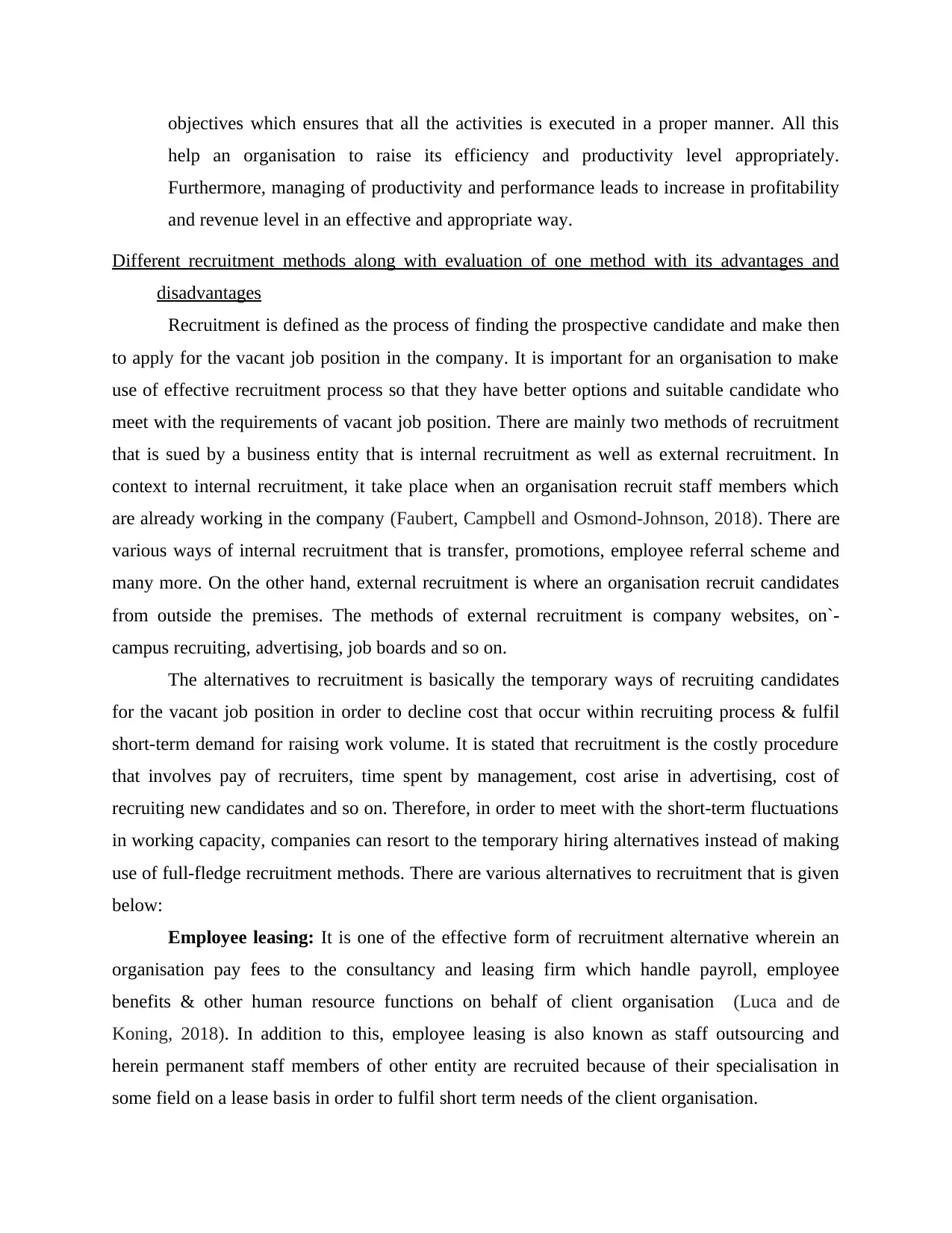
objectives which ensures that all the activities is executed in a proper manner. All this
help an organisation to raise its efficiency and productivity level appropriately.
Furthermore, managing of productivity and performance leads to increase in profitability
and revenue level in an effective and appropriate way.
Different recruitment methods along with evaluation of one method with its advantages and
disadvantages
Recruitment is defined as the process of finding the prospective candidate and make then
to apply for the vacant job position in the company. It is important for an organisation to make
use of effective recruitment process so that they have better options and suitable candidate who
meet with the requirements of vacant job position. There are mainly two methods of recruitment
that is sued by a business entity that is internal recruitment as well as external recruitment. In
context to internal recruitment, it take place when an organisation recruit staff members which
are already working in the company (Faubert, Campbell and Osmond-Johnson, 2018). There are
various ways of internal recruitment that is transfer, promotions, employee referral scheme and
many more. On the other hand, external recruitment is where an organisation recruit candidates
from outside the premises. The methods of external recruitment is company websites, on`-
campus recruiting, advertising, job boards and so on.
The alternatives to recruitment is basically the temporary ways of recruiting candidates
for the vacant job position in order to decline cost that occur within recruiting process & fulfil
short-term demand for raising work volume. It is stated that recruitment is the costly procedure
that involves pay of recruiters, time spent by management, cost arise in advertising, cost of
recruiting new candidates and so on. Therefore, in order to meet with the short-term fluctuations
in working capacity, companies can resort to the temporary hiring alternatives instead of making
use of full-fledge recruitment methods. There are various alternatives to recruitment that is given
below:
Employee leasing: It is one of the effective form of recruitment alternative wherein an
organisation pay fees to the consultancy and leasing firm which handle payroll, employee
benefits & other human resource functions on behalf of client organisation (Luca and de
Koning, 2018). In addition to this, employee leasing is also known as staff outsourcing and
herein permanent staff members of other entity are recruited because of their specialisation in
some field on a lease basis in order to fulfil short term needs of the client organisation.
help an organisation to raise its efficiency and productivity level appropriately.
Furthermore, managing of productivity and performance leads to increase in profitability
and revenue level in an effective and appropriate way.
Different recruitment methods along with evaluation of one method with its advantages and
disadvantages
Recruitment is defined as the process of finding the prospective candidate and make then
to apply for the vacant job position in the company. It is important for an organisation to make
use of effective recruitment process so that they have better options and suitable candidate who
meet with the requirements of vacant job position. There are mainly two methods of recruitment
that is sued by a business entity that is internal recruitment as well as external recruitment. In
context to internal recruitment, it take place when an organisation recruit staff members which
are already working in the company (Faubert, Campbell and Osmond-Johnson, 2018). There are
various ways of internal recruitment that is transfer, promotions, employee referral scheme and
many more. On the other hand, external recruitment is where an organisation recruit candidates
from outside the premises. The methods of external recruitment is company websites, on`-
campus recruiting, advertising, job boards and so on.
The alternatives to recruitment is basically the temporary ways of recruiting candidates
for the vacant job position in order to decline cost that occur within recruiting process & fulfil
short-term demand for raising work volume. It is stated that recruitment is the costly procedure
that involves pay of recruiters, time spent by management, cost arise in advertising, cost of
recruiting new candidates and so on. Therefore, in order to meet with the short-term fluctuations
in working capacity, companies can resort to the temporary hiring alternatives instead of making
use of full-fledge recruitment methods. There are various alternatives to recruitment that is given
below:
Employee leasing: It is one of the effective form of recruitment alternative wherein an
organisation pay fees to the consultancy and leasing firm which handle payroll, employee
benefits & other human resource functions on behalf of client organisation (Luca and de
Koning, 2018). In addition to this, employee leasing is also known as staff outsourcing and
herein permanent staff members of other entity are recruited because of their specialisation in
some field on a lease basis in order to fulfil short term needs of the client organisation.
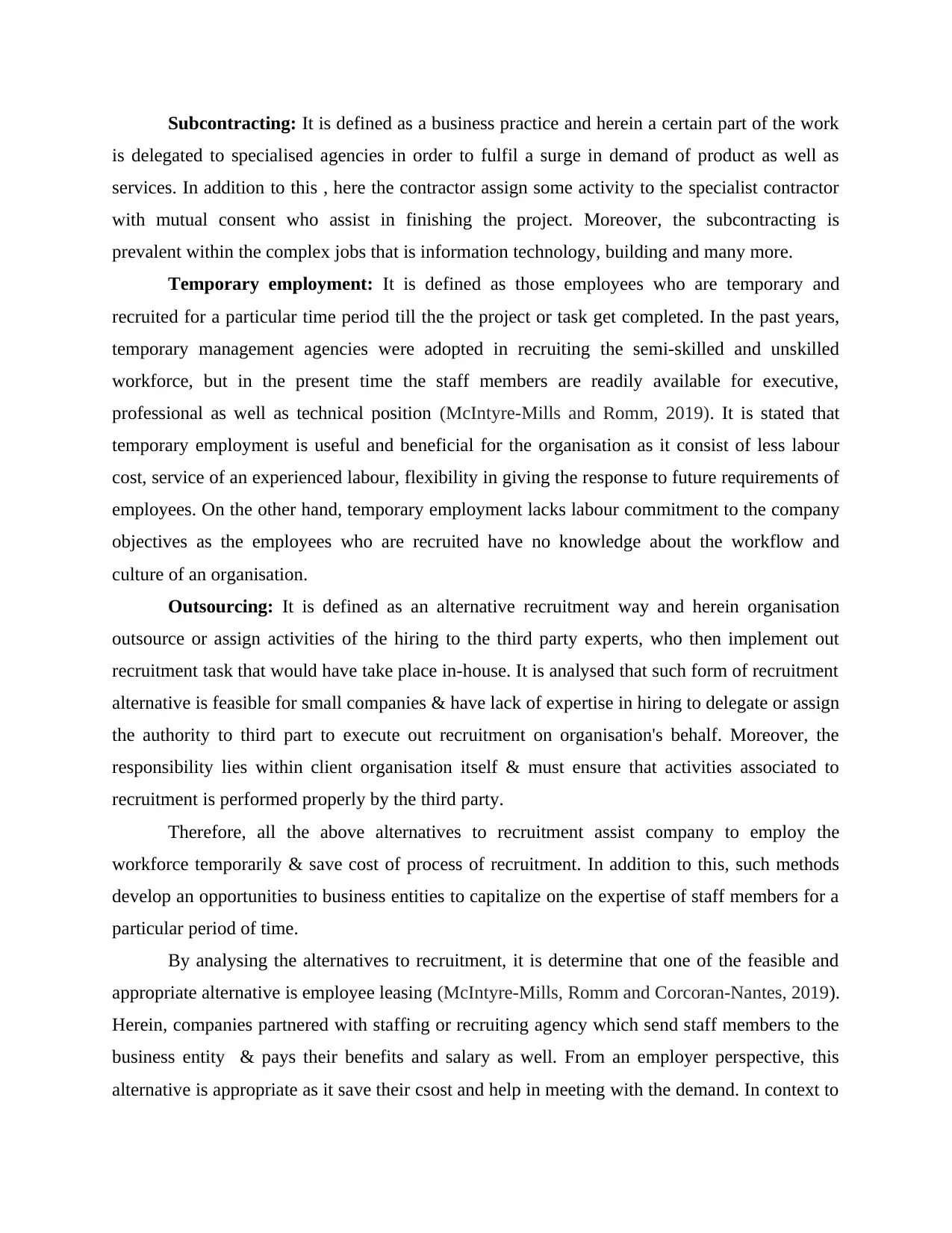
Subcontracting: It is defined as a business practice and herein a certain part of the work
is delegated to specialised agencies in order to fulfil a surge in demand of product as well as
services. In addition to this , here the contractor assign some activity to the specialist contractor
with mutual consent who assist in finishing the project. Moreover, the subcontracting is
prevalent within the complex jobs that is information technology, building and many more.
Temporary employment: It is defined as those employees who are temporary and
recruited for a particular time period till the the project or task get completed. In the past years,
temporary management agencies were adopted in recruiting the semi-skilled and unskilled
workforce, but in the present time the staff members are readily available for executive,
professional as well as technical position (McIntyre-Mills and Romm, 2019). It is stated that
temporary employment is useful and beneficial for the organisation as it consist of less labour
cost, service of an experienced labour, flexibility in giving the response to future requirements of
employees. On the other hand, temporary employment lacks labour commitment to the company
objectives as the employees who are recruited have no knowledge about the workflow and
culture of an organisation.
Outsourcing: It is defined as an alternative recruitment way and herein organisation
outsource or assign activities of the hiring to the third party experts, who then implement out
recruitment task that would have take place in-house. It is analysed that such form of recruitment
alternative is feasible for small companies & have lack of expertise in hiring to delegate or assign
the authority to third part to execute out recruitment on organisation's behalf. Moreover, the
responsibility lies within client organisation itself & must ensure that activities associated to
recruitment is performed properly by the third party.
Therefore, all the above alternatives to recruitment assist company to employ the
workforce temporarily & save cost of process of recruitment. In addition to this, such methods
develop an opportunities to business entities to capitalize on the expertise of staff members for a
particular period of time.
By analysing the alternatives to recruitment, it is determine that one of the feasible and
appropriate alternative is employee leasing (McIntyre-Mills, Romm and Corcoran-Nantes, 2019).
Herein, companies partnered with staffing or recruiting agency which send staff members to the
business entity & pays their benefits and salary as well. From an employer perspective, this
alternative is appropriate as it save their csost and help in meeting with the demand. In context to
is delegated to specialised agencies in order to fulfil a surge in demand of product as well as
services. In addition to this , here the contractor assign some activity to the specialist contractor
with mutual consent who assist in finishing the project. Moreover, the subcontracting is
prevalent within the complex jobs that is information technology, building and many more.
Temporary employment: It is defined as those employees who are temporary and
recruited for a particular time period till the the project or task get completed. In the past years,
temporary management agencies were adopted in recruiting the semi-skilled and unskilled
workforce, but in the present time the staff members are readily available for executive,
professional as well as technical position (McIntyre-Mills and Romm, 2019). It is stated that
temporary employment is useful and beneficial for the organisation as it consist of less labour
cost, service of an experienced labour, flexibility in giving the response to future requirements of
employees. On the other hand, temporary employment lacks labour commitment to the company
objectives as the employees who are recruited have no knowledge about the workflow and
culture of an organisation.
Outsourcing: It is defined as an alternative recruitment way and herein organisation
outsource or assign activities of the hiring to the third party experts, who then implement out
recruitment task that would have take place in-house. It is analysed that such form of recruitment
alternative is feasible for small companies & have lack of expertise in hiring to delegate or assign
the authority to third part to execute out recruitment on organisation's behalf. Moreover, the
responsibility lies within client organisation itself & must ensure that activities associated to
recruitment is performed properly by the third party.
Therefore, all the above alternatives to recruitment assist company to employ the
workforce temporarily & save cost of process of recruitment. In addition to this, such methods
develop an opportunities to business entities to capitalize on the expertise of staff members for a
particular period of time.
By analysing the alternatives to recruitment, it is determine that one of the feasible and
appropriate alternative is employee leasing (McIntyre-Mills, Romm and Corcoran-Nantes, 2019).
Herein, companies partnered with staffing or recruiting agency which send staff members to the
business entity & pays their benefits and salary as well. From an employer perspective, this
alternative is appropriate as it save their csost and help in meeting with the demand. In context to
⊘ This is a preview!⊘
Do you want full access?
Subscribe today to unlock all pages.

Trusted by 1+ million students worldwide
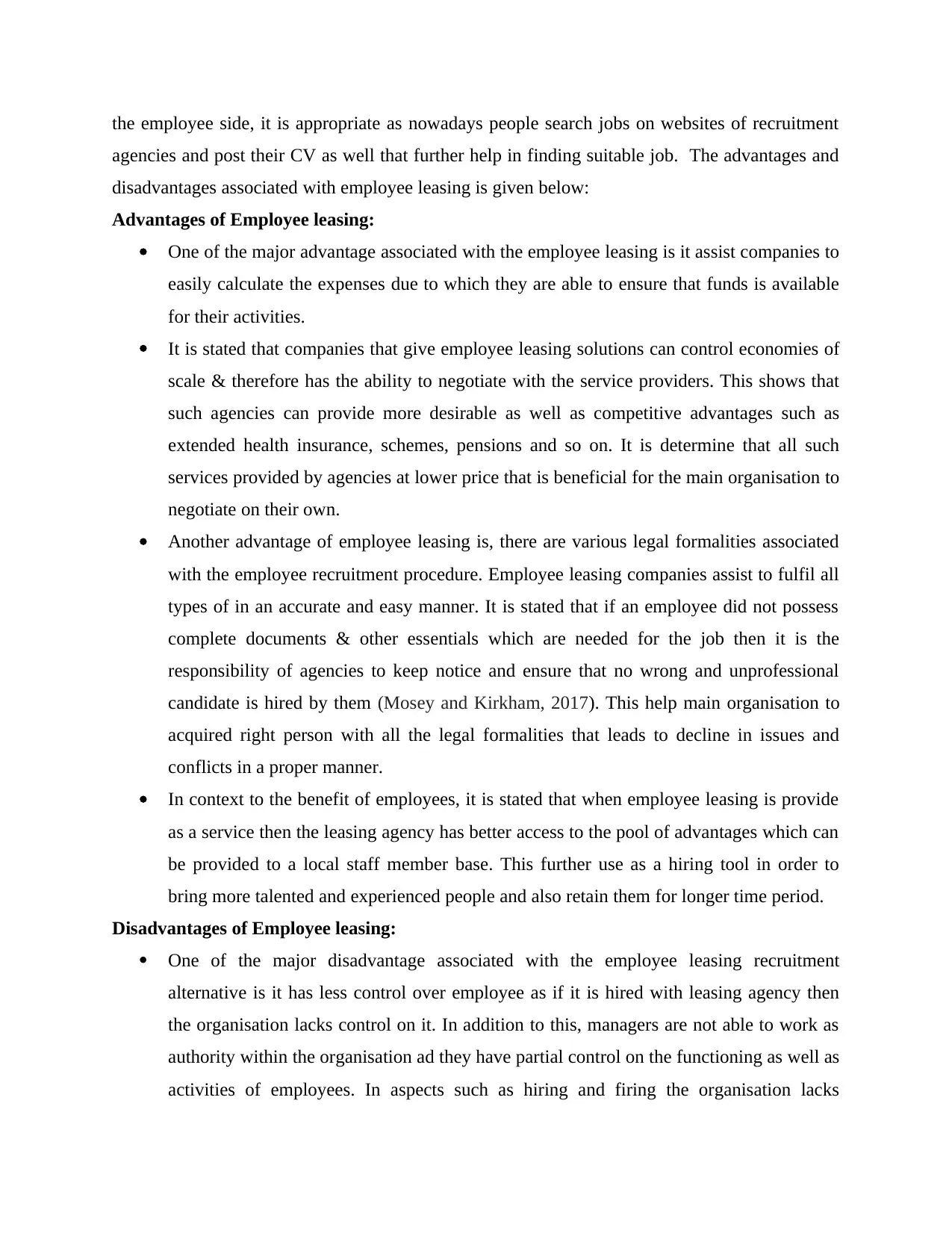
the employee side, it is appropriate as nowadays people search jobs on websites of recruitment
agencies and post their CV as well that further help in finding suitable job. The advantages and
disadvantages associated with employee leasing is given below:
Advantages of Employee leasing:
One of the major advantage associated with the employee leasing is it assist companies to
easily calculate the expenses due to which they are able to ensure that funds is available
for their activities.
It is stated that companies that give employee leasing solutions can control economies of
scale & therefore has the ability to negotiate with the service providers. This shows that
such agencies can provide more desirable as well as competitive advantages such as
extended health insurance, schemes, pensions and so on. It is determine that all such
services provided by agencies at lower price that is beneficial for the main organisation to
negotiate on their own.
Another advantage of employee leasing is, there are various legal formalities associated
with the employee recruitment procedure. Employee leasing companies assist to fulfil all
types of in an accurate and easy manner. It is stated that if an employee did not possess
complete documents & other essentials which are needed for the job then it is the
responsibility of agencies to keep notice and ensure that no wrong and unprofessional
candidate is hired by them (Mosey and Kirkham, 2017). This help main organisation to
acquired right person with all the legal formalities that leads to decline in issues and
conflicts in a proper manner.
In context to the benefit of employees, it is stated that when employee leasing is provide
as a service then the leasing agency has better access to the pool of advantages which can
be provided to a local staff member base. This further use as a hiring tool in order to
bring more talented and experienced people and also retain them for longer time period.
Disadvantages of Employee leasing:
One of the major disadvantage associated with the employee leasing recruitment
alternative is it has less control over employee as if it is hired with leasing agency then
the organisation lacks control on it. In addition to this, managers are not able to work as
authority within the organisation ad they have partial control on the functioning as well as
activities of employees. In aspects such as hiring and firing the organisation lacks
agencies and post their CV as well that further help in finding suitable job. The advantages and
disadvantages associated with employee leasing is given below:
Advantages of Employee leasing:
One of the major advantage associated with the employee leasing is it assist companies to
easily calculate the expenses due to which they are able to ensure that funds is available
for their activities.
It is stated that companies that give employee leasing solutions can control economies of
scale & therefore has the ability to negotiate with the service providers. This shows that
such agencies can provide more desirable as well as competitive advantages such as
extended health insurance, schemes, pensions and so on. It is determine that all such
services provided by agencies at lower price that is beneficial for the main organisation to
negotiate on their own.
Another advantage of employee leasing is, there are various legal formalities associated
with the employee recruitment procedure. Employee leasing companies assist to fulfil all
types of in an accurate and easy manner. It is stated that if an employee did not possess
complete documents & other essentials which are needed for the job then it is the
responsibility of agencies to keep notice and ensure that no wrong and unprofessional
candidate is hired by them (Mosey and Kirkham, 2017). This help main organisation to
acquired right person with all the legal formalities that leads to decline in issues and
conflicts in a proper manner.
In context to the benefit of employees, it is stated that when employee leasing is provide
as a service then the leasing agency has better access to the pool of advantages which can
be provided to a local staff member base. This further use as a hiring tool in order to
bring more talented and experienced people and also retain them for longer time period.
Disadvantages of Employee leasing:
One of the major disadvantage associated with the employee leasing recruitment
alternative is it has less control over employee as if it is hired with leasing agency then
the organisation lacks control on it. In addition to this, managers are not able to work as
authority within the organisation ad they have partial control on the functioning as well as
activities of employees. In aspects such as hiring and firing the organisation lacks
Paraphrase This Document
Need a fresh take? Get an instant paraphrase of this document with our AI Paraphraser
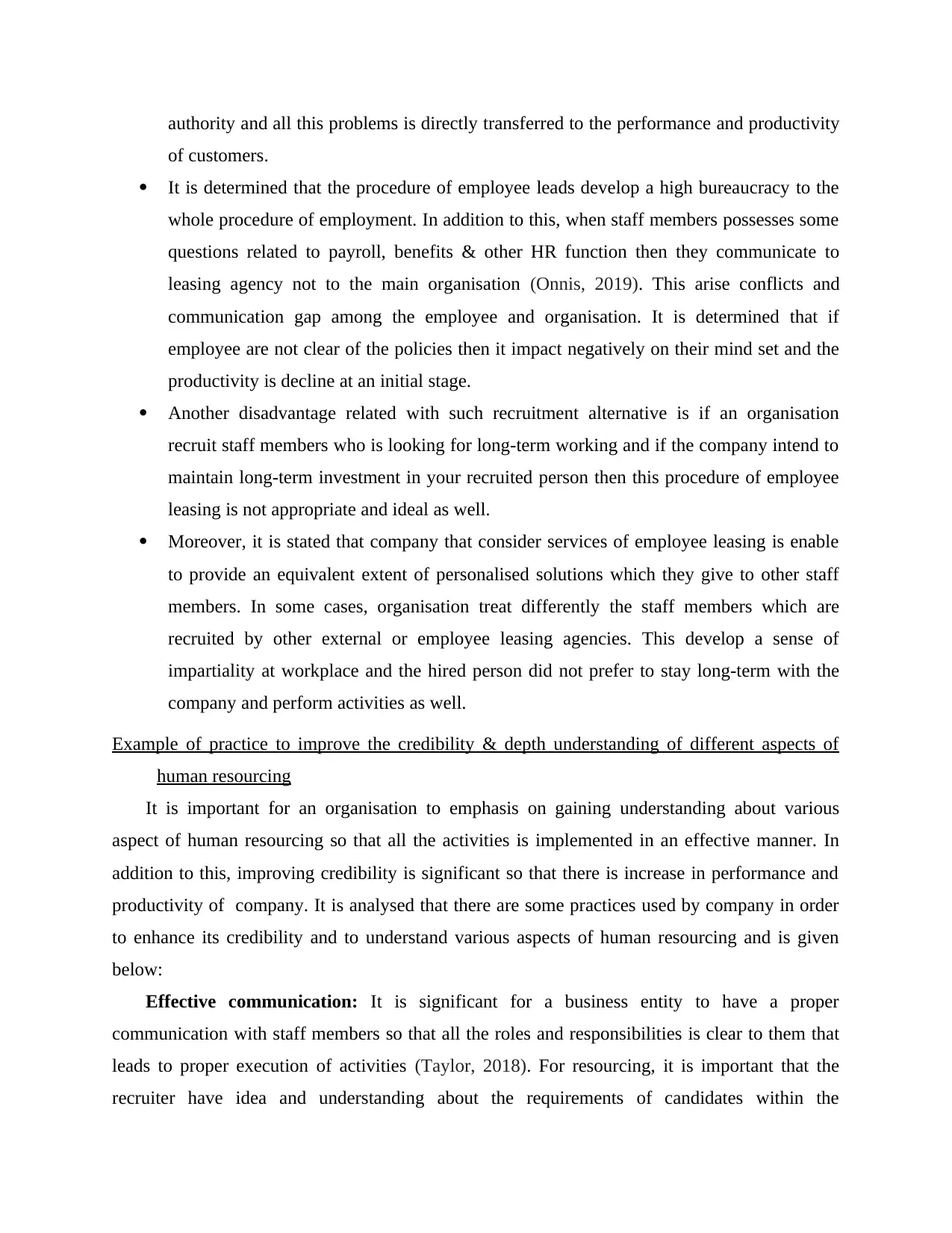
authority and all this problems is directly transferred to the performance and productivity
of customers.
It is determined that the procedure of employee leads develop a high bureaucracy to the
whole procedure of employment. In addition to this, when staff members possesses some
questions related to payroll, benefits & other HR function then they communicate to
leasing agency not to the main organisation (Onnis, 2019). This arise conflicts and
communication gap among the employee and organisation. It is determined that if
employee are not clear of the policies then it impact negatively on their mind set and the
productivity is decline at an initial stage.
Another disadvantage related with such recruitment alternative is if an organisation
recruit staff members who is looking for long-term working and if the company intend to
maintain long-term investment in your recruited person then this procedure of employee
leasing is not appropriate and ideal as well.
Moreover, it is stated that company that consider services of employee leasing is enable
to provide an equivalent extent of personalised solutions which they give to other staff
members. In some cases, organisation treat differently the staff members which are
recruited by other external or employee leasing agencies. This develop a sense of
impartiality at workplace and the hired person did not prefer to stay long-term with the
company and perform activities as well.
Example of practice to improve the credibility & depth understanding of different aspects of
human resourcing
It is important for an organisation to emphasis on gaining understanding about various
aspect of human resourcing so that all the activities is implemented in an effective manner. In
addition to this, improving credibility is significant so that there is increase in performance and
productivity of company. It is analysed that there are some practices used by company in order
to enhance its credibility and to understand various aspects of human resourcing and is given
below:
Effective communication: It is significant for a business entity to have a proper
communication with staff members so that all the roles and responsibilities is clear to them that
leads to proper execution of activities (Taylor, 2018). For resourcing, it is important that the
recruiter have idea and understanding about the requirements of candidates within the
of customers.
It is determined that the procedure of employee leads develop a high bureaucracy to the
whole procedure of employment. In addition to this, when staff members possesses some
questions related to payroll, benefits & other HR function then they communicate to
leasing agency not to the main organisation (Onnis, 2019). This arise conflicts and
communication gap among the employee and organisation. It is determined that if
employee are not clear of the policies then it impact negatively on their mind set and the
productivity is decline at an initial stage.
Another disadvantage related with such recruitment alternative is if an organisation
recruit staff members who is looking for long-term working and if the company intend to
maintain long-term investment in your recruited person then this procedure of employee
leasing is not appropriate and ideal as well.
Moreover, it is stated that company that consider services of employee leasing is enable
to provide an equivalent extent of personalised solutions which they give to other staff
members. In some cases, organisation treat differently the staff members which are
recruited by other external or employee leasing agencies. This develop a sense of
impartiality at workplace and the hired person did not prefer to stay long-term with the
company and perform activities as well.
Example of practice to improve the credibility & depth understanding of different aspects of
human resourcing
It is important for an organisation to emphasis on gaining understanding about various
aspect of human resourcing so that all the activities is implemented in an effective manner. In
addition to this, improving credibility is significant so that there is increase in performance and
productivity of company. It is analysed that there are some practices used by company in order
to enhance its credibility and to understand various aspects of human resourcing and is given
below:
Effective communication: It is significant for a business entity to have a proper
communication with staff members so that all the roles and responsibilities is clear to them that
leads to proper execution of activities (Taylor, 2018). For resourcing, it is important that the
recruiter have idea and understanding about the requirements of candidates within the
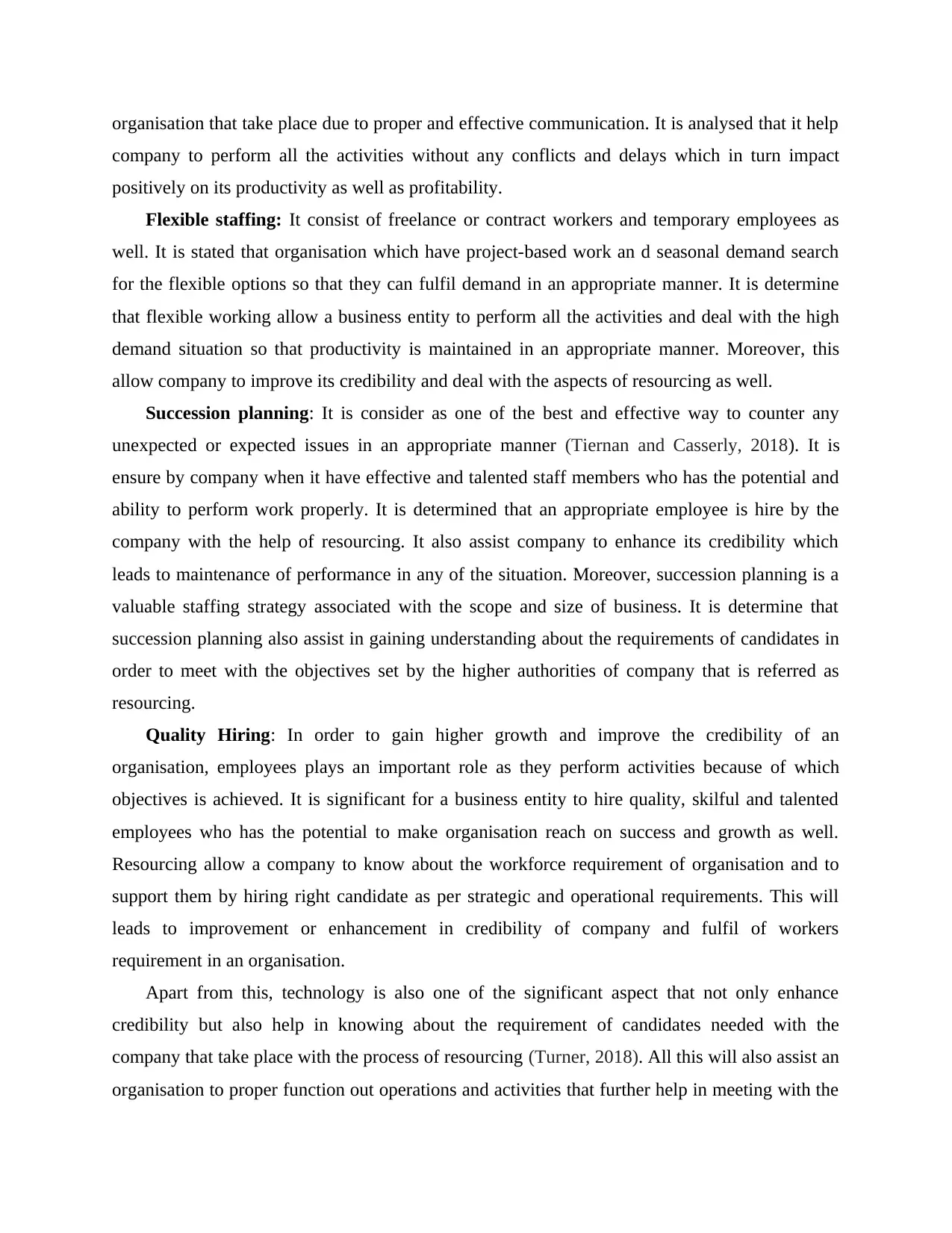
organisation that take place due to proper and effective communication. It is analysed that it help
company to perform all the activities without any conflicts and delays which in turn impact
positively on its productivity as well as profitability.
Flexible staffing: It consist of freelance or contract workers and temporary employees as
well. It is stated that organisation which have project-based work an d seasonal demand search
for the flexible options so that they can fulfil demand in an appropriate manner. It is determine
that flexible working allow a business entity to perform all the activities and deal with the high
demand situation so that productivity is maintained in an appropriate manner. Moreover, this
allow company to improve its credibility and deal with the aspects of resourcing as well.
Succession planning: It is consider as one of the best and effective way to counter any
unexpected or expected issues in an appropriate manner (Tiernan and Casserly, 2018). It is
ensure by company when it have effective and talented staff members who has the potential and
ability to perform work properly. It is determined that an appropriate employee is hire by the
company with the help of resourcing. It also assist company to enhance its credibility which
leads to maintenance of performance in any of the situation. Moreover, succession planning is a
valuable staffing strategy associated with the scope and size of business. It is determine that
succession planning also assist in gaining understanding about the requirements of candidates in
order to meet with the objectives set by the higher authorities of company that is referred as
resourcing.
Quality Hiring: In order to gain higher growth and improve the credibility of an
organisation, employees plays an important role as they perform activities because of which
objectives is achieved. It is significant for a business entity to hire quality, skilful and talented
employees who has the potential to make organisation reach on success and growth as well.
Resourcing allow a company to know about the workforce requirement of organisation and to
support them by hiring right candidate as per strategic and operational requirements. This will
leads to improvement or enhancement in credibility of company and fulfil of workers
requirement in an organisation.
Apart from this, technology is also one of the significant aspect that not only enhance
credibility but also help in knowing about the requirement of candidates needed with the
company that take place with the process of resourcing (Turner, 2018). All this will also assist an
organisation to proper function out operations and activities that further help in meeting with the
company to perform all the activities without any conflicts and delays which in turn impact
positively on its productivity as well as profitability.
Flexible staffing: It consist of freelance or contract workers and temporary employees as
well. It is stated that organisation which have project-based work an d seasonal demand search
for the flexible options so that they can fulfil demand in an appropriate manner. It is determine
that flexible working allow a business entity to perform all the activities and deal with the high
demand situation so that productivity is maintained in an appropriate manner. Moreover, this
allow company to improve its credibility and deal with the aspects of resourcing as well.
Succession planning: It is consider as one of the best and effective way to counter any
unexpected or expected issues in an appropriate manner (Tiernan and Casserly, 2018). It is
ensure by company when it have effective and talented staff members who has the potential and
ability to perform work properly. It is determined that an appropriate employee is hire by the
company with the help of resourcing. It also assist company to enhance its credibility which
leads to maintenance of performance in any of the situation. Moreover, succession planning is a
valuable staffing strategy associated with the scope and size of business. It is determine that
succession planning also assist in gaining understanding about the requirements of candidates in
order to meet with the objectives set by the higher authorities of company that is referred as
resourcing.
Quality Hiring: In order to gain higher growth and improve the credibility of an
organisation, employees plays an important role as they perform activities because of which
objectives is achieved. It is significant for a business entity to hire quality, skilful and talented
employees who has the potential to make organisation reach on success and growth as well.
Resourcing allow a company to know about the workforce requirement of organisation and to
support them by hiring right candidate as per strategic and operational requirements. This will
leads to improvement or enhancement in credibility of company and fulfil of workers
requirement in an organisation.
Apart from this, technology is also one of the significant aspect that not only enhance
credibility but also help in knowing about the requirement of candidates needed with the
company that take place with the process of resourcing (Turner, 2018). All this will also assist an
organisation to proper function out operations and activities that further help in meeting with the
⊘ This is a preview!⊘
Do you want full access?
Subscribe today to unlock all pages.

Trusted by 1+ million students worldwide
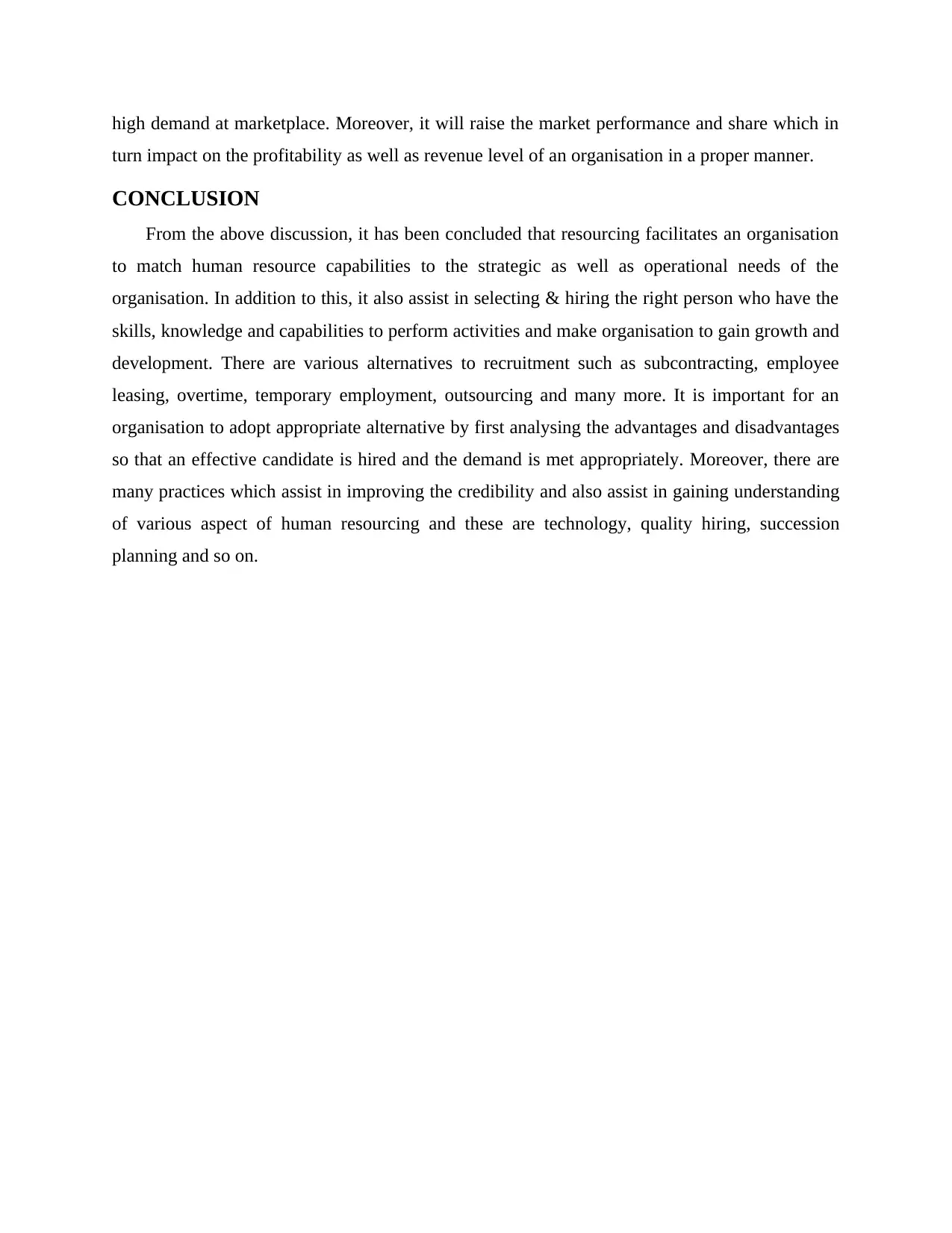
high demand at marketplace. Moreover, it will raise the market performance and share which in
turn impact on the profitability as well as revenue level of an organisation in a proper manner.
CONCLUSION
From the above discussion, it has been concluded that resourcing facilitates an organisation
to match human resource capabilities to the strategic as well as operational needs of the
organisation. In addition to this, it also assist in selecting & hiring the right person who have the
skills, knowledge and capabilities to perform activities and make organisation to gain growth and
development. There are various alternatives to recruitment such as subcontracting, employee
leasing, overtime, temporary employment, outsourcing and many more. It is important for an
organisation to adopt appropriate alternative by first analysing the advantages and disadvantages
so that an effective candidate is hired and the demand is met appropriately. Moreover, there are
many practices which assist in improving the credibility and also assist in gaining understanding
of various aspect of human resourcing and these are technology, quality hiring, succession
planning and so on.
turn impact on the profitability as well as revenue level of an organisation in a proper manner.
CONCLUSION
From the above discussion, it has been concluded that resourcing facilitates an organisation
to match human resource capabilities to the strategic as well as operational needs of the
organisation. In addition to this, it also assist in selecting & hiring the right person who have the
skills, knowledge and capabilities to perform activities and make organisation to gain growth and
development. There are various alternatives to recruitment such as subcontracting, employee
leasing, overtime, temporary employment, outsourcing and many more. It is important for an
organisation to adopt appropriate alternative by first analysing the advantages and disadvantages
so that an effective candidate is hired and the demand is met appropriately. Moreover, there are
many practices which assist in improving the credibility and also assist in gaining understanding
of various aspect of human resourcing and these are technology, quality hiring, succession
planning and so on.
Paraphrase This Document
Need a fresh take? Get an instant paraphrase of this document with our AI Paraphraser
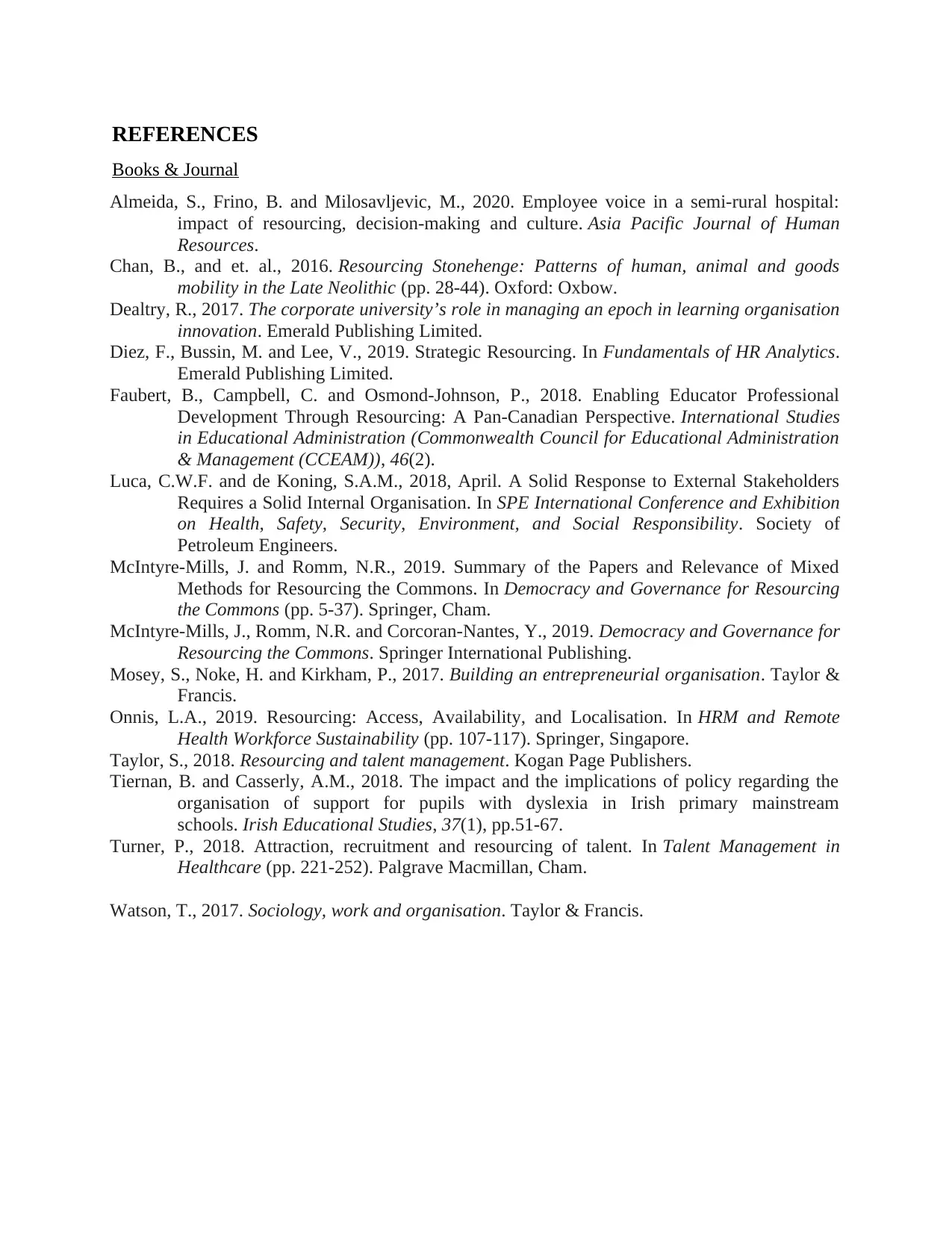
REFERENCES
Books & Journal
Almeida, S., Frino, B. and Milosavljevic, M., 2020. Employee voice in a semi‐rural hospital:
impact of resourcing, decision‐making and culture. Asia Pacific Journal of Human
Resources.
Chan, B., and et. al., 2016. Resourcing Stonehenge: Patterns of human, animal and goods
mobility in the Late Neolithic (pp. 28-44). Oxford: Oxbow.
Dealtry, R., 2017. The corporate university’s role in managing an epoch in learning organisation
innovation. Emerald Publishing Limited.
Diez, F., Bussin, M. and Lee, V., 2019. Strategic Resourcing. In Fundamentals of HR Analytics.
Emerald Publishing Limited.
Faubert, B., Campbell, C. and Osmond-Johnson, P., 2018. Enabling Educator Professional
Development Through Resourcing: A Pan-Canadian Perspective. International Studies
in Educational Administration (Commonwealth Council for Educational Administration
& Management (CCEAM)), 46(2).
Luca, C.W.F. and de Koning, S.A.M., 2018, April. A Solid Response to External Stakeholders
Requires a Solid Internal Organisation. In SPE International Conference and Exhibition
on Health, Safety, Security, Environment, and Social Responsibility. Society of
Petroleum Engineers.
McIntyre-Mills, J. and Romm, N.R., 2019. Summary of the Papers and Relevance of Mixed
Methods for Resourcing the Commons. In Democracy and Governance for Resourcing
the Commons (pp. 5-37). Springer, Cham.
McIntyre-Mills, J., Romm, N.R. and Corcoran-Nantes, Y., 2019. Democracy and Governance for
Resourcing the Commons. Springer International Publishing.
Mosey, S., Noke, H. and Kirkham, P., 2017. Building an entrepreneurial organisation. Taylor &
Francis.
Onnis, L.A., 2019. Resourcing: Access, Availability, and Localisation. In HRM and Remote
Health Workforce Sustainability (pp. 107-117). Springer, Singapore.
Taylor, S., 2018. Resourcing and talent management. Kogan Page Publishers.
Tiernan, B. and Casserly, A.M., 2018. The impact and the implications of policy regarding the
organisation of support for pupils with dyslexia in Irish primary mainstream
schools. Irish Educational Studies, 37(1), pp.51-67.
Turner, P., 2018. Attraction, recruitment and resourcing of talent. In Talent Management in
Healthcare (pp. 221-252). Palgrave Macmillan, Cham.
Watson, T., 2017. Sociology, work and organisation. Taylor & Francis.
Books & Journal
Almeida, S., Frino, B. and Milosavljevic, M., 2020. Employee voice in a semi‐rural hospital:
impact of resourcing, decision‐making and culture. Asia Pacific Journal of Human
Resources.
Chan, B., and et. al., 2016. Resourcing Stonehenge: Patterns of human, animal and goods
mobility in the Late Neolithic (pp. 28-44). Oxford: Oxbow.
Dealtry, R., 2017. The corporate university’s role in managing an epoch in learning organisation
innovation. Emerald Publishing Limited.
Diez, F., Bussin, M. and Lee, V., 2019. Strategic Resourcing. In Fundamentals of HR Analytics.
Emerald Publishing Limited.
Faubert, B., Campbell, C. and Osmond-Johnson, P., 2018. Enabling Educator Professional
Development Through Resourcing: A Pan-Canadian Perspective. International Studies
in Educational Administration (Commonwealth Council for Educational Administration
& Management (CCEAM)), 46(2).
Luca, C.W.F. and de Koning, S.A.M., 2018, April. A Solid Response to External Stakeholders
Requires a Solid Internal Organisation. In SPE International Conference and Exhibition
on Health, Safety, Security, Environment, and Social Responsibility. Society of
Petroleum Engineers.
McIntyre-Mills, J. and Romm, N.R., 2019. Summary of the Papers and Relevance of Mixed
Methods for Resourcing the Commons. In Democracy and Governance for Resourcing
the Commons (pp. 5-37). Springer, Cham.
McIntyre-Mills, J., Romm, N.R. and Corcoran-Nantes, Y., 2019. Democracy and Governance for
Resourcing the Commons. Springer International Publishing.
Mosey, S., Noke, H. and Kirkham, P., 2017. Building an entrepreneurial organisation. Taylor &
Francis.
Onnis, L.A., 2019. Resourcing: Access, Availability, and Localisation. In HRM and Remote
Health Workforce Sustainability (pp. 107-117). Springer, Singapore.
Taylor, S., 2018. Resourcing and talent management. Kogan Page Publishers.
Tiernan, B. and Casserly, A.M., 2018. The impact and the implications of policy regarding the
organisation of support for pupils with dyslexia in Irish primary mainstream
schools. Irish Educational Studies, 37(1), pp.51-67.
Turner, P., 2018. Attraction, recruitment and resourcing of talent. In Talent Management in
Healthcare (pp. 221-252). Palgrave Macmillan, Cham.
Watson, T., 2017. Sociology, work and organisation. Taylor & Francis.
1 out of 11
Related Documents
Your All-in-One AI-Powered Toolkit for Academic Success.
+13062052269
info@desklib.com
Available 24*7 on WhatsApp / Email
![[object Object]](/_next/static/media/star-bottom.7253800d.svg)
Unlock your academic potential
Copyright © 2020–2025 A2Z Services. All Rights Reserved. Developed and managed by ZUCOL.





